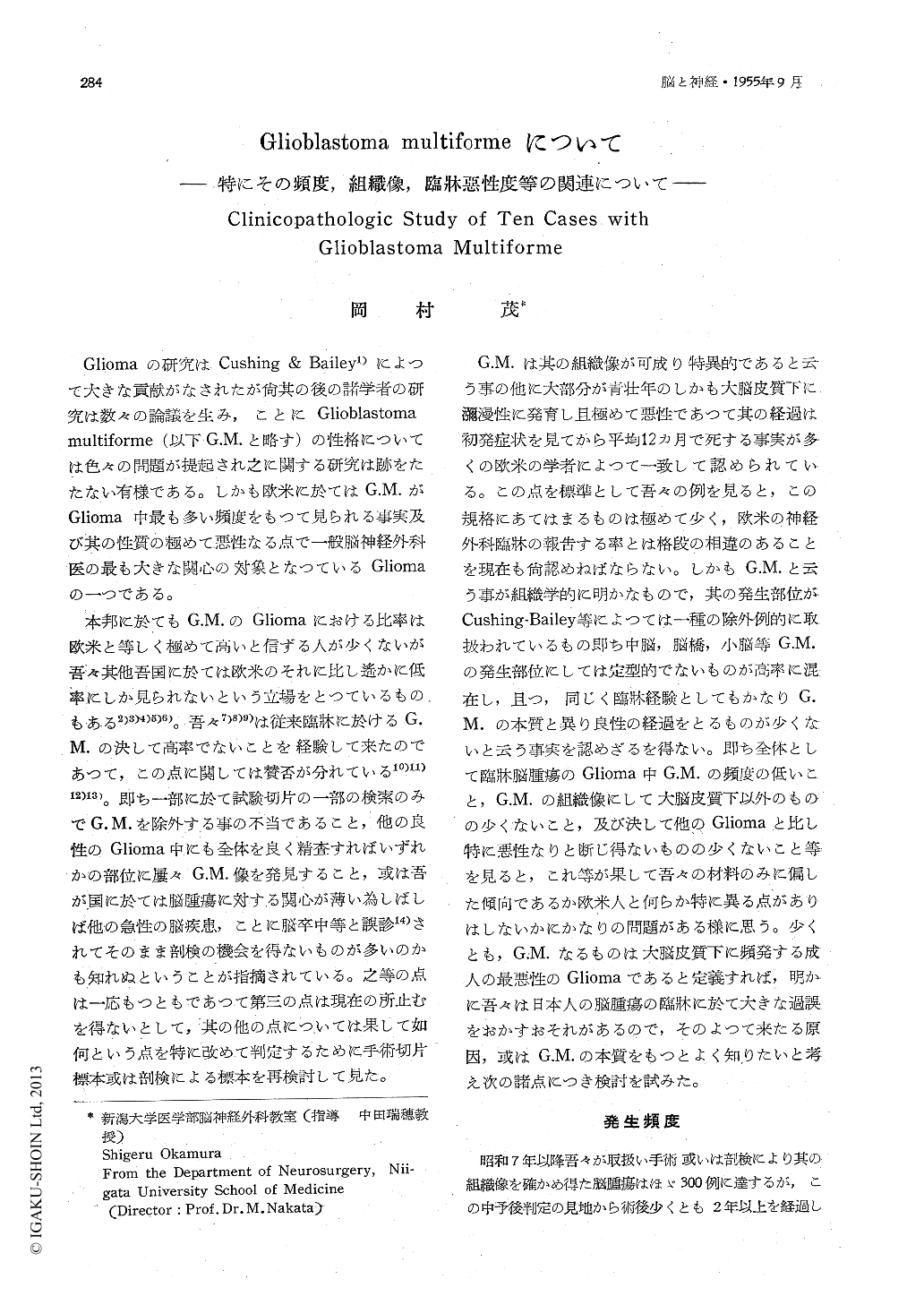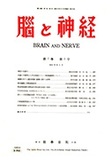Japanese
English
- 有料閲覧
- Abstract 文献概要
- 1ページ目 Look Inside
Gliomaの研究はCushing&Bailey1)によつて大きな貢献がなされたが尚其の後の諸学者の研究は数々の論議を生み,ことにGlioblastoma multiforme (以下G.M.と略す)の性格については色々の問題が提起され之に関する研究は跡をたたない有様である。しかも欧米に於てはG. M.がGlioma中最も多い頻度をもつて見られる事実及び其の性質の極めて悪性なる点で一般脳神経外科医の最も大きな関心の対象となつているGliomaの一つである。
本邦に於てもG. M.のGliomaにおける比率は欧米と等しく極めて高いと信ずる人が少くないが吾々其他吾国に於ては欧米のそれに比し遙かに低率にしか見られないという立場をとつているものもある2)3)4)5)6)。吾々7)8)9)は従来臨牀に於けるG. M.の決して高率でないことを経験して来たのであつて,この点に関しては賛否が分れている10)11)12)13)。即ち一部に於て試験切片の一部の検索のみでG.M.を除外する事の不当であること,他の良性のGlioma中にも全体を良く精査すればいずれかの部位に屡々G.M.像を発見すること,或は吾が国に於ては脳腫瘍に対する関心が薄い為しばしば他の急性の脳疾患,ことに脳卒中等と誤診14)されてそのまま剖検の機会を得ないものが多いのかも知れぬということが指摘されている。之等の点は一応もつともであって第三の点は現在の所止むを得ないとして,其の他の点については果して如何という点を特に改めて判定するために手術切片標本或は剖検による標本を再検討して見た。
In a follow-up study of ten patients with glio-blastoma multiforirne verified microscopically, we have found a relationship between the pathol-ogical characteristics and the longevity of the patients.
We have based our microscopic diagnosis of glioblastoma multiforme on a histogenetic sche-ma according to Bailey and Cushings classifica-tion of gliomas. We have experienced only a few cases of glioblastoma multiforme and, more over, more than half of the cases have been those with long survival.
Several authors have subdivided glioblastoma multiforme into two or three groups on the basis of the microscopic characteristics and co-rrelated them with the survival time of the patients.
We attempted to classify our cases in their manners but the attempt was unsuccessful.
So we tried to subdivide them in other way and found out that they can be subdivided into two groups on the basis of some histological evidences of malignancy (cellularity, mitoses, giant cells, etc.).
1. In the Neurosurgical Department of the Niigata University School of Medicine, there have been 220 patients with verified intracranial tumors. Of these,85 patients (39.5%) had glio-mas. And the 10 patients who had verified glio-blastoma multiforme comprised 11.5% of the gliomas and only 4.5% of all the intracranial tumors.
2. On the basis of the microscopic chara-cteristics, the tumors were divided into two groups, Group Ⅰ and Ⅱ. Of the ten cases, three belonged to Group Ⅰ and seven to Group Ⅱ.
3. The cellular density (the number of cells seen in a microscopic high-power field of Ⅹ 600) has been calculated in all these cases.
The average number of cells were 403 in Gr-oup Ⅰ and 228 in Group Ⅱ.
4. Mitotic figures were abundant in Group Ⅰ, averaging 4 or 5 in every microscopic high-power field. In Group Ⅱ, mitotic figures were present but were by count far less frequent than in Group Ⅰ.
5. Giant cells, proliferation of the wall of the blood vessels, hemorrhage and necrosis were all a little more frequent and extensive in Group Ⅰ.
6. According to the longevity, there was a marked difference between these subgroups. The average duration of symptoms before admission were 6 months in Group Ⅰ ane 14 months in Group Ⅱ. And the average duration from the first symptom to exitus were 10 and 68 months respectively, and 2 cases of Group Ⅱ are still alive.
7. As to the age of the patients on admission there also was a marked difference between these subgroups. They were 38.7 and 25.6 years respectively.
8. In all the cases of Group Ⅰ, the tumors were located in the subcortical region of the cerebral hemisphere. In. Group Ⅱ, however, two were infratentorial in location, one in the cere-bellum and another in the pons.

Copyright © 1955, Igaku-Shoin Ltd. All rights reserved.


